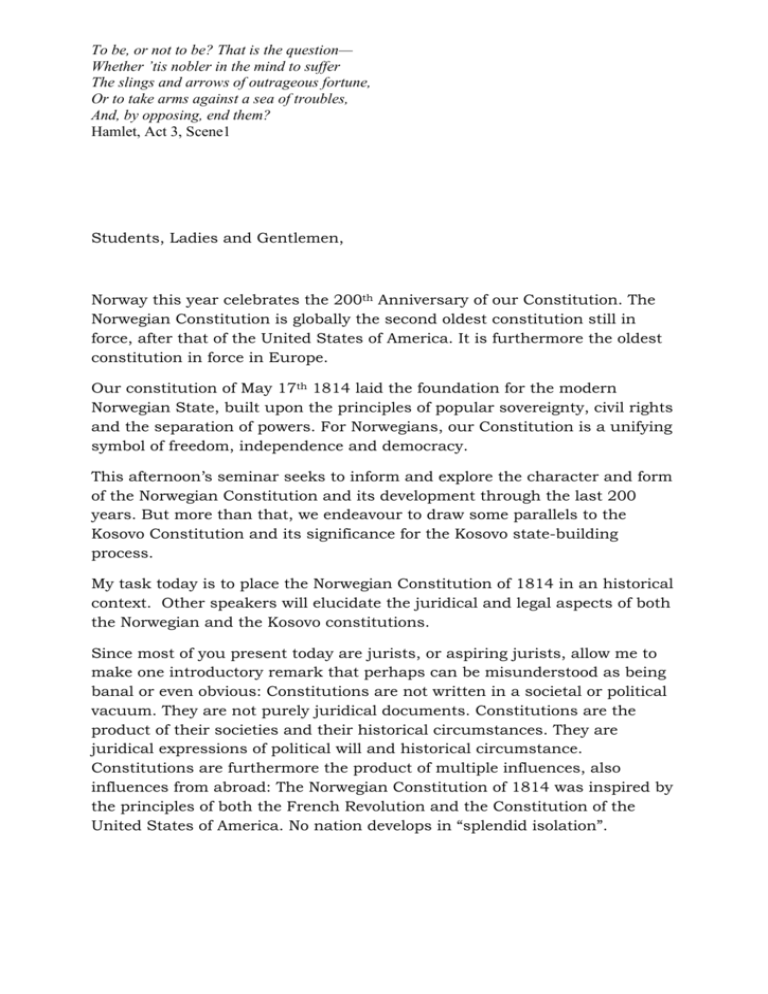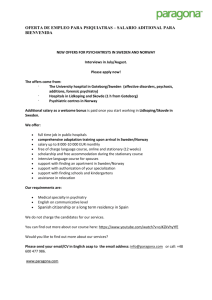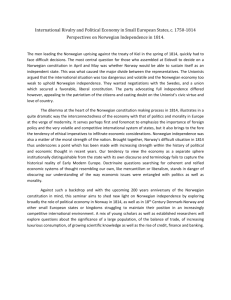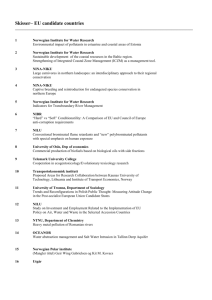here. - Norway - the official site in Kosovo
advertisement

To be, or not to be? That is the question— Whether ’tis nobler in the mind to suffer The slings and arrows of outrageous fortune, Or to take arms against a sea of troubles, And, by opposing, end them? Hamlet, Act 3, Scene1 Students, Ladies and Gentlemen, Norway this year celebrates the 200th Anniversary of our Constitution. The Norwegian Constitution is globally the second oldest constitution still in force, after that of the United States of America. It is furthermore the oldest constitution in force in Europe. Our constitution of May 17th 1814 laid the foundation for the modern Norwegian State, built upon the principles of popular sovereignty, civil rights and the separation of powers. For Norwegians, our Constitution is a unifying symbol of freedom, independence and democracy. This afternoon’s seminar seeks to inform and explore the character and form of the Norwegian Constitution and its development through the last 200 years. But more than that, we endeavour to draw some parallels to the Kosovo Constitution and its significance for the Kosovo state-building process. My task today is to place the Norwegian Constitution of 1814 in an historical context. Other speakers will elucidate the juridical and legal aspects of both the Norwegian and the Kosovo constitutions. Since most of you present today are jurists, or aspiring jurists, allow me to make one introductory remark that perhaps can be misunderstood as being banal or even obvious: Constitutions are not written in a societal or political vacuum. They are not purely juridical documents. Constitutions are the product of their societies and their historical circumstances. They are juridical expressions of political will and historical circumstance. Constitutions are furthermore the product of multiple influences, also influences from abroad: The Norwegian Constitution of 1814 was inspired by the principles of both the French Revolution and the Constitution of the United States of America. No nation develops in “splendid isolation”. [Type text] Great Power Politics The year 1814 was a watershed in modern Norwegian and Scandinavian history. After some twenty years of European warfare, from the War of the First Coalition beginning in 1793, through Napoleon’s rout outside Moscow in 1812 and his defeat at Leipzig in October 1813, the shifting tides of war entered a final phase culminating with the ultimate defeat of Napoleon’s army at Waterloo on June 18, 1815. From a Scandinavian point of view, the battle of Leipzig is of paramount importance. Scandinavia had not been a peaceful region for close to 200 years when the Napoleonic wars began in earnest. (Northern War1563-1570, 1643, 1655, 1672, to mention but a few wars) The region was dominated by the “conglomerate” Kingdom of Denmark-Norway and the Kingdom of Sweden. Norway had been under the Danish Crown since 1380, a period referred to by some Norwegian historians of the 19th century as “the 400 year night”. In 1804, Sweden joined the alliance of the UK and Russia against Napoleonic France. Denmark remained neutral. In 1807, Napoleon forced Russia (and Prussia) to sign the Treaty of Tilsit, committing Russia to join with France, whereupon Russia attacked Sweden and took Finland in 1808/09. Denmark-Norway was seen as supporting France and in March 1808 Swedish forces attacked Norway. After some immediate battlefield success, the Swedish forces were driven out of Norway and an armistice was declared. The British, suspicious of Danish intentions, attacked Copenhagen and bombarded the city to ashes in 1807, capturing the Danish navy at the same time. Denmark thereupon joined forces with Napoleon, bringing a reluctant Norway with it. Norway’s main trading partner at the time, besides Denmark, was the UK. This development led to a British naval blockade that severely affected Norway, stopping grain imports and threatening the country with starvation after several poor harvests. In Sweden, a palace coup resulted in the French general, Jean Baptiste Bernadotte, being elected crown prince in 1810. Bernadotte took the name Carl Johan and promptly turned against his former leader Napoleon and allied Sweden with the UK and Russia. The Kingdom of Denmark-Norway was allied with France. Napoleon’s defeat at Leipzig in October 1813 resulted in Denmark being subjected to extensive diplomatic and military pressure. The northern army, under the command of Carl Johan, attacked Denmark and occupied the Danish-German duchies of Slesvig and Holstein. Danish King Frederik VI, 2 [Type text] fearing further offensives against the Danish heartland, agreed to Carl Johan’s demands – supported by the UK - in return for immediate withdrawal from the Danish areas. In the Treaty of Kiel, of 14 January 1814, King Frederik VI of Denmark ceded Norway to Sweden, this being a compensation for Sweden’s earlier loss of Finland to Russia. The loss of Norway deprived Denmark of 85% of the kingdom’s territory and 36% of its population. It also set into motion events that would lead to the “coup de grace” of the Danish kingdom in the defeat of 1864 when Schleswig-Holstein was taken by Prussia. The Norwegian reaction However, complications arose when Norwegians – and the governor of Norway, the Danish Crown Prince Christian Fredrik - refused to accept the terms of the Kiel Treaty. This opened for confrontation, not only with Sweden, but also with the Great powers, who were determined that Norway must be given to Sweden under the terms of the international treaty, the Treaty of Kiel. The legal starting point for the Norwegian elite was the fact that the Danish king, by accepting the terms of the Treaty of Kiel had relinquished his claim to Norway. The Middle-Age absolutist constitutional law of Denmark-Norway, (Kongeloven, 1661) which was strongly influenced by the natural law thinkers such as Hugo Grotius and Samuel Pufendorf, held that national sovereignty ultimately rested with the people, who had transferred it to the King of their own free will. According to this, the King could under no circumstances transfer sovereignty to another monarch. If the King wished to relinquish his sovereign rule, it could only revert to the people. By relinquishing his claim to Norway, the Danish King had, in this line of thinking, absolved Norwegians of their oath of allegiance to him. They had, in effect, been set free. Christian Fredrik, had, in fact, considered whether he should claim the kingship of Norway based on his hereditary rights as Danish Crown Prince. He embarked on a journey through central Norway in order to convince Norwegian notables and the population at large that they should support his claim to the Norwegian throne. In Trondheim, however, Christian Fredrik received a veritable “cold shower”: He was met with written demands that Norway should become a Constitutional Monarchy. In other words, the King 3 [Type text] should be subject to the authority of a national assembly. This was a clear break from the thinking that had prevailed during the Danish-Norwegian absolutist monarchy. The proposal was clearly influenced by the ideas emanating from the French Revolution and Rousseau’s theory of a “Social Contract” (1762), but it was also based on the thinking from the Kings law of 1662 and earlier mediaeval traditions. This was an expression of the concept of popular sovereignty that authority emanates from the people and is delegated to the Monarch, the national assembly and the government. After a meeting of Norwegian notables with Christian Fredrik in February (16)1814, the prince agreed to find his role within the framework of a constitutional monarchy. In reality, he had no other choice. The meeting of notables also decided that a meeting should be convened to write a Constitution for Norway. Time was of the essence. The longer the process continued, the greater the risk was that Sweden would invade Norway with the support of the Great Powers. Christian Frederik ordered the Bishop of the Norwegian Lutheran Church to instruct all priests to convene an extraordinary church service throughout the country. Within weeks (25 February) an extraordinary church service was held in all churches. After the church service, the congregations were asked to swear an oath of allegiance to Norway: “Swear to assert Norway’s independence and to venture life and blood for the beloved Fatherland.” Thereafter the congregations elected representatives to regional meetings that in turn elected participants to the Constitutional Assembly that was convened at Eidsvoll on April 10th 1814. Of the 112 representatives that met at Eidsvoll, 57 were government officials of various types, 18 were businesspeople and 37 were farmers. 25 came from cities, 54 from rural districts and 33 from army and naval units. The average age was 42 years, while almost all were between the age of 40 and 50. The youngest was 17 years of age. They were all men. While we from today’s perspective can say that the process and the constitution itself were not especially “democratic”, we should nonetheless understand that for that time, the Norwegian Constitution was the most liberal and democratic Constitution in Europe. The Constitution will be explained in more detail by Judge Brathole, so I will not address the Constitution itself. 4 [Type text] 1814 The “miraculous year” The doyen of Norwegian historians, Sverre Steen (1898-1983) once wrote that it is one thing to know what took place in 1814, and quite another to understand why it happened as it did: “Let us not in our arrogance and pride imagine that we can explain what happened in 1814…” . What is clear is that no one other than Norwegians wanted Norway to be independent. This outcome was indeed only one of many possible. Perhaps it is also true to say that it was the least possible outcome, given the configuration of Great power politics and the weakness of the fledgling Norwegian state and society. Until the defeat of Napoleon, Swedish forces were preoccupied on the Continent and did not have the full capacity to force their will upon Norway. In this situation, with the Danish King having relinquished his power over Norway, there was in fact a power vacuum that was utilized to full effect by the Norwegian elites in order to gain independence. Truly they “seized the moment”. After Paris was occupied by Allied forces in April 1814, the Great Powers, as well as Sweden, came back to the “Norwegian problem”. The movement for Norwegian independence had gathered strength and political momentum and by the time foreign envoys from the Great Powers came to Christiania in late May, they were too late. The British diplomat, Lord Castlereagh, was adamantly opposed to Norwegian independence and firmly held that the provisions of the Kiel Treaty had to be fulfilled. His reasons were several, not only his concern for the balance of power in Europe and his belief in the necessity of fulfilling treaty obligations as a norm of international behavior, if not law. Castlereagh was also firmly convinced that Norwegian independence was out of the question because the Norwegians were not ready to govern themselves. According to a report by a Danish diplomat, Castlereagh “knows that Norway is not strong enough to form an independent state, that it would only be a kind of pirate state, very unpleasant for the whole world.” Sweden initially refused to accept anything that had been decided at Eidsvoll and after inconclusive negotiations, Sweden attacked Norway. The battles were short and inconclusive; although it is clear that Sweden had the greater military might and might have prevailed if they had persevered. 5 [Type text] The Treaty of Moss (14 August 1814) resulted in Swedish acceptance of the Constitution and the National Assembly – the Storting. Norway accepted to enter into a Union with Sweden, but as an independent nation with its own sovereign institutions. The necessary constitutional amendments were adopted by the Storting on 4th November 1814. In other words, it was not a case of Sweden incorporating Norway, but a union of two equal and independent states. Norway entered the year 1814 under the Danish Crown, as it had been since 1380. Great Power politics in Europe created conditions and space within which Norwegians found the opportunity to maneuver. Principles of government, first and foremost the principle of the sovereignty of the people, set the standard for the political movement for independence. Unilateral declaration of independence through the creation of the Constitution and a national assembly – Storting – were the result. The forced union with Sweden was entered into not as an amalgamation with Sweden, but as a union between two independent states under one joint King. Norwegians had begun the year as subjects of the Danish king and by year’s end had achieved a constitutional status as citizens of an independent state. Full independence was, however, finally achieved in 1905 when Norway – again unilaterally – declared independence from Sweden and elected a Danish prince as our King. But that is another saga for another time. Thank you for your attention! 6





